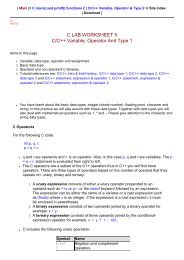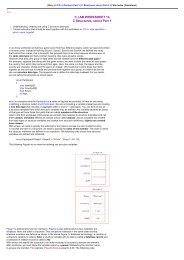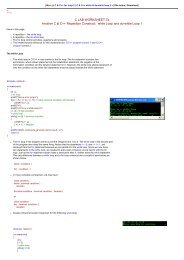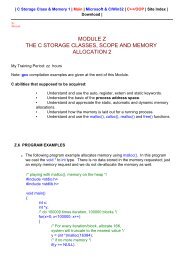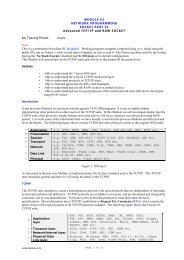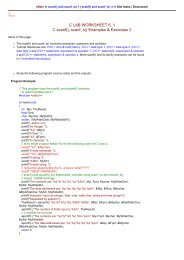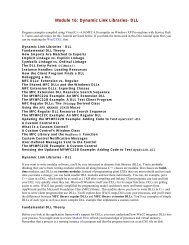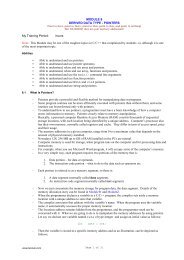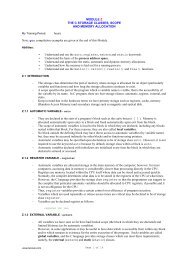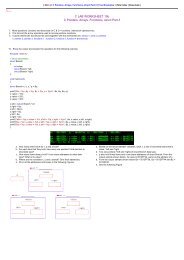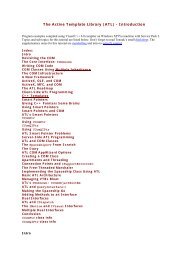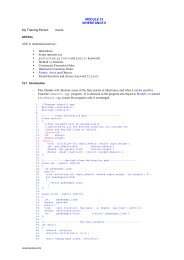C struct, typedef, enum & union - Tenouk C & C++
C struct, typedef, enum & union - Tenouk C & C++
C struct, typedef, enum & union - Tenouk C & C++
Create successful ePaper yourself
Turn your PDF publications into a flip-book with our unique Google optimized e-Paper software.
STRUCT, TYPEDEF, ENUM& UNIONIn this session we will learn <strong>struct</strong> and <strong>union</strong> types,<strong>typedef</strong> and <strong>enum</strong>www.tenouk.com, © 1/93
STRUCT, TYPEDEF, ENUM & UNIONStructure (<strong>struct</strong>)• With array, we can only declare one data type per array.• For different data type, we need another arraydeclaration.• It is single type aggregate data type.• Struct overcomes this problem by declaring compositedata types which can consist different types.• A <strong>struct</strong>ure is a collection of related data items stored inone place and can be referenced by more than onenames.• These data items are different basic data types. So, th<strong>enum</strong>ber of bytes required to store them may also vary.• A <strong>struct</strong>ure type is a user-defined composite type.• It is composed of fields or members which can bedifferent types.www.tenouk.com, © 2/93
STRUCT, TYPEDEF, ENUM & UNION• In <strong>C++</strong>, a <strong>struct</strong> is same as a class except that itsmembers are public by default.• In order to use a <strong>struct</strong>ure, we must first declare a <strong>struct</strong>uretemplate.• The variables in a <strong>struct</strong>ure are called elements or members.• In C, you must explicitly use the <strong>struct</strong> keyword to declare a<strong>struct</strong>ure however in <strong>C++</strong>, this is unnecessary, once the typehas been defined.• In C99, the allowable data types for a bit field include qualifiedand unqualified _Bool, signed int, and unsigned int.• The default integer type for a bit field is signed.• You have the option of declaring variables when the <strong>struct</strong>uretype is defined by placing one or more comma-separatedvariable names between the closing brace and the semicolon.www.tenouk.com, © 3/93
STRUCT, TYPEDEF, ENUM & UNION• Structure variables can be initialized. The initialization for eachvariable must be enclosed in braces.• Both <strong>struct</strong>ure types and variables follow the same scope asnormal variables, as do all identifiers.• If you define a <strong>struct</strong>ure within a function, then you can only useit within that function.• Likewise if you define a <strong>struct</strong>ure outside of any function then itcan be used in any place throughout your program.• Example, to store and process a student’s record with theelements chIdNum (identification number), chName, chGenderand nAge, we can declare the following <strong>struct</strong>ure,tag<strong>struct</strong> student {char chIdNum[5];char chName[10];char chGender;int nAge;};www.tenouk.com, © 4/93
STRUCT, TYPEDEF, ENUM & UNION• Here, <strong>struct</strong> is a keyword that tells the compilerthat a <strong>struct</strong>ure template is being declared andstudent is a tag that identifies its data <strong>struct</strong>ure.• Tag is not a variable; it is a label for the <strong>struct</strong>ure’stemplate.• Note that there is a semicolon after the closingcurly brace.• A <strong>struct</strong>ure tag simply a label for the <strong>struct</strong>ure’stemplate but you name the <strong>struct</strong>ure tag using thesame rules for naming variables.www.tenouk.com, © 5/93
STRUCT, TYPEDEF, ENUM & UNION• The previous sample template for the <strong>struct</strong>urecan be illustrated as follow (note the differentdata sizes),www.tenouk.com, © 6/93
STRUCT, TYPEDEF, ENUM & UNIONDefine, declare and initialize• Compiler will not reserve memory for a <strong>struct</strong>ure until it isdeclared.• A <strong>struct</strong>ure declaration names a type and specifies a sequenceof variable values called 'members' or 'fields' of the <strong>struct</strong>urethat can have different types.• An optional identifier, called a 'tag', gives the name of the<strong>struct</strong>ure type and can be used in subsequent references tothe <strong>struct</strong>ure type.• A variable of that <strong>struct</strong>ure type holds the entire sequencedefined by that type.• Declaring <strong>struct</strong>ure variables can be done in the following way,<strong>struct</strong> MyEmployee{ char chName[20];int nIdNum;long nDepatment;} EmpData;// defines a <strong>struct</strong>ure variable named EmpDatawww.tenouk.com, © 7/93
STRUCT, TYPEDEF, ENUM & UNION• The <strong>struct</strong> MyEmployee <strong>struct</strong>ure has threemembers: chName, nIdNum, and nDepatment.• The chName member is a 20-element array, andnIdNum and nDepatment are simple memberswith int and long types, respectively.• The identifier MyEmployee is the <strong>struct</strong>ureidentifier.• Then we can declare variables of type <strong>struct</strong>MyEmployee like the following,<strong>struct</strong> MyEmployee student, staff, academician;Struct basic examplewww.tenouk.com, © 8/93
STRUCT, TYPEDEF, ENUM & UNION• Another example, anonymous <strong>struct</strong> (<strong>struct</strong> withouttag),Struct /* defines an anonymous <strong>struct</strong> and a */{ /* <strong>struct</strong>ure variable named area */float fwidth, flength;} area;• The area <strong>struct</strong>ure has two members with float type,fwidth and flength.• The <strong>struct</strong>ure type has no tag and is therefore is unnamedor anonymous.• The nested <strong>struct</strong>ures, called anonymous <strong>struct</strong>ures allowsyou to declare a <strong>struct</strong>ure variable within another <strong>struct</strong>urewithout giving it a name.• However, <strong>C++</strong> does not allow anonymous <strong>struct</strong>ures.• You can access the members of an anonymous <strong>struct</strong>ureas if they were members in the containing <strong>struct</strong>ure.www.tenouk.com, © 9/93
STRUCT, TYPEDEF, ENUM & UNION• Anonymous <strong>struct</strong>ure examplewww.tenouk.com, © 10/93
STRUCT, TYPEDEF, ENUM & UNION• Anonymous <strong>struct</strong>ures can be useful when the tag namedis not needed.• This is the case when one declaration defines all <strong>struct</strong>ureinstances.• Embedded or nested <strong>struct</strong>ures are often anonymous. Forexample,<strong>struct</strong> MyCube{<strong>struct</strong> /* anonymous <strong>struct</strong>ure */{int width, length;} area;int height;} CubeData;• Nested <strong>struct</strong>ures can also be accessed as though theywere declared at the file-scope level.www.tenouk.com, © 11/93
STRUCT, TYPEDEF, ENUM & UNION• Nested <strong>struct</strong>ure examplewww.tenouk.com, © 12/93
STRUCT, TYPEDEF, ENUM & UNION• Optionally, we can declare variables when the<strong>struct</strong>ure type is defined by placing one or morecomma-separated variable names between theclosing brace and the semicolon.• Structure variables can be initialized.• The initialization for each variable must beenclosed in braces.• Define & declare <strong>struct</strong>ure examplewww.tenouk.com, © 13/93
STRUCT, TYPEDEF, ENUM & UNION• Define, declare & initialize a <strong>struct</strong>ure example• Define, declare & initialize a <strong>struct</strong>ure example 2www.tenouk.com, © 14/93
STRUCT, TYPEDEF, ENUM & UNIONDeclaring and Using Bit Fields in Structures• A <strong>struct</strong>ure declarator can also be a specifiednumber of bits, called a 'bit field'.• Its length is set off from the declarator for the fieldname by a colon.• A bit field is interpreted as an integral type.• Both C and <strong>C++</strong> allow integer members to be storedinto memory spaces smaller than the compiler wouldordinarily allow.• These space-saving <strong>struct</strong>ure members bit fields,and their width in bits can be explicitly declared.• Used in programs that must force a data <strong>struct</strong>ure tocorrespond to a fixed hardware representation and itis not portable.www.tenouk.com, © 15/93
STRUCT, TYPEDEF, ENUM & UNION• A bit field declaration contains a type specifier followed by anoptional declarator, a colon, a constant integer expression thatindicates the field width in bits, and a semicolon.type-specifier declarator opt : constant-expression;• A bit field declaration may not use either of the type qualifiers,const or volatile.• The following <strong>struct</strong>ure example has four bit-field membersleft, right, front and rear, occupying 4, 3, 4 and 5 bitsrespectively,<strong>struct</strong> direction { // declare direction bit fieldint left : 4; // 00000000 0000XXXXint right : 3; // 00000000 0XXX0000int front : 4; // 00000XXX X0000000int rear : 5; // XXXXX000 00000000};• In this case, total bits is 16, equal to 2 bytes.www.tenouk.com, © 16/93
STRUCT, TYPEDEF, ENUM & UNION• The following restrictions apply to bitfields. You cannot,1. Define an array of bit fields.2. Take the address of a bit field.3. Have a pointer to a bit field.4. Have a reference to a bit field.www.tenouk.com, © 17/93
STRUCT, TYPEDEF, ENUM & UNIONAlignment of Bit Fields• If a series of bit fields does not add up to the size of an int, paddingcan take place.• The amount of padding is determined by the alignmentcharacteristics of the members of the <strong>struct</strong>ure.• The following example demonstrates padding.• Suppose that an int occupies 4 bytes (4 x 8 = 32 bits). The exampledeclares the identifier onoffpower to be of type <strong>struct</strong>switching,<strong>struct</strong> switching {unsigned light : 1;unsigned fridge : 1;int count; /* 4 bytes */unsigned stove : 4;unsigned : 4;unsigned radio : 1;unsigned : 0;unsigned flag : 1;} onoffpower ;www.tenouk.com, © 18/93
STRUCT, TYPEDEF, ENUM & UNION• The <strong>struct</strong>ure switching contains eight members totaling 16 bytes.• The following table describes the storage that each memberoccupies,Member Name Storage Occupied Total Totallight 1 bit 1 bitfridge 1 bit 1 bit32 bits(padding up to 30 bits) To the next int boundary 30 bitscount The size of an int (4 bytes) 4 x 8 = 32 bits 32 bitsstove 4 bits 4 bits(unnamed field) 4 bits 4 bitsradio 1 bit 1 bit32 bits(padding up to 23 bits)To the next int boundary 23 bits(unnamed field)flag 1 bit 1 bit(padding up to 31 bits) To the next int boundary 31 bits32 bits16 bytes = 64 bits 4 x 32 bits = 128 bits 128 bitswww.tenouk.com, © 19/93
STRUCT, TYPEDEF, ENUM & UNION• All references to <strong>struct</strong>ure fields must be fully qualified. For instance,you cannot reference the second field by fridge.• You must reference this field by onoffpower.fridge.• The following expression sets the light field to 1,onoffpower.light = 1;• When you assign to a bit field a value that is out of its range, the bitpattern is preserved and the appropriate bits are assigned.• The following expression sets the fridge field of the onoffpower<strong>struct</strong>ure to 0 because only the least significant bit is assigned to thefridge field,onoffpower.fridge = 2;• But the following expression sets the fridge field of the onoffpower<strong>struct</strong>ure to 1.onoffpower.fridge = 5;www.tenouk.com, © 20/93
STRUCT, TYPEDEF, ENUM & UNION• Bit fields <strong>struct</strong>ure example• Real implementation examples can be found in theLinux socket programming in fabricating the udp, tcp, ipand other protocol headers.www.tenouk.com, © 21/93
STRUCT, TYPEDEF, ENUM & UNIONAccessing the Structure Member• A "member-selection expression" refers tomembers of <strong>struct</strong>ures (and <strong>union</strong>s, classes).• Such an expression has the value and type of theselected member.• The member access operators . (dot) and ->(arrow: minus + greater than symbols) are usedto refer to members of <strong>struct</strong>ures (also <strong>union</strong>sand classes).• Member access expressions have the value andtype of the selected member.• There are two methods that can be used toaccess the members using dot or an arrowoperator.www.tenouk.com, © 22/93
STRUCT, TYPEDEF, ENUM & UNION• The two syntaxes are,1. postfix-expression. Identifier2. postfix-expression –> identifier• In the first form, postfix-expression represents a value of<strong>struct</strong> (or <strong>union</strong>, class object) type and identifier names amember of the specified <strong>struct</strong>ure (or <strong>union</strong>, class object).• The value of the operation is that of identifier and is an leftvalueif postfix-expression is an left-value.• In the second form, postfix-expression represents a pointerto a <strong>struct</strong>ure or <strong>union</strong>, and identifier names a member ofthe specified <strong>struct</strong>ure or <strong>union</strong>.• The value is that of identifier and is an left-value.• The two forms of member-selection expressions have similareffects.www.tenouk.com, © 23/93
STRUCT, TYPEDEF, ENUM & UNION• An expression involving arrow member-selectionoperator (->) is a shorthand version of anexpression using the dot (.) if the expressionbefore the dot consists of the indirection operator(*) applied to a pointer value.• Therefore,expression->identifier• is equivalent to,(*expression).identifier• provided that expression is a pointer valuewhich is normally the case.www.tenouk.com, © 24/93
STRUCT, TYPEDEF, ENUM & UNION• How to access <strong>struct</strong>ure member example• A member-selection expression for the justitem<strong>struct</strong>ure is,justitem.pSctPtr = &justitem;• In this case, the address of the justitem <strong>struct</strong>ure isassigned to the pSctPtr member of the <strong>struct</strong>ure.• This means that justitem contains a pointer to itself.www.tenouk.com, © 25/93
STRUCT, TYPEDEF, ENUM & UNION(justitem.pSctPtr)->nNumA = 33;• In this case, the pointer expressionjustitem.pSctPtr is used with the memberselectionoperator (–>) to assign a value of 33 tothe member nNumA.justalist[8].nNumB = 44;• This statement shows how to access and selectan individual <strong>struct</strong>ure member from an array of<strong>struct</strong>ures.• An integer 44 was assigned to nNumBjustalist's ninth <strong>struct</strong>ure member.www.tenouk.com, © 26/93
STRUCT, TYPEDEF, ENUM & UNIONArrays of Structures• Suppose you would like to store and manipulate the record of 100students.• It would be tedious and unproductive to create 100 different studentarray variables and work with them individually.• It would be much easier to create an array of student <strong>struct</strong>ures.• Structures of the same type can be grouped together into an array.• We can declare an array of <strong>struct</strong>ures just like we declare a normalarray variable.• e.g., for 100 student records, we can declare a <strong>struct</strong>ure like thefollowing,<strong>struct</strong> student{int nIdNum, nAge;char chName[80];char chGender;}studRecord[100];www.tenouk.com, © 27/93
STRUCT, TYPEDEF, ENUM & UNION• Or something like the following statements,<strong>struct</strong> student{int nIdNum, nAge;char chName[80];char chGender;};• And later in our program we can declaresomething like this,<strong>struct</strong> student studRecord[100];• This statement declares 100 variables of type<strong>struct</strong> student.www.tenouk.com, © 28/93
STRUCT, TYPEDEF, ENUM & UNION• As in arrays, we can use a subscript to reference aparticular student record.• For example, to print the name of the seventh student, wecould write the following statement,printf("%\n", studRecord[6].chName;• Example of initializing all the student names to blanks andtheir ages to 0, we could do this simply by using for loopas shown below,for(i=0; i
STRUCT, TYPEDEF, ENUM & UNION• Array of <strong>struct</strong>ure program examplewww.tenouk.com, © 30/93
STRUCT, TYPEDEF, ENUM & UNION• Example demonstrates <strong>struct</strong>ure containing arrayswww.tenouk.com, © 31/93
STRUCT, TYPEDEF, ENUM & UNION• Example demonstrates array of <strong>struct</strong>ure that containingarrays• So, takenote onthedifferencebetweenan arrayof<strong>struct</strong>ureand<strong>struct</strong>urecontainingarray.www.tenouk.com, © 32/93
STRUCT, TYPEDEF, ENUM & UNIONStructure and Function• Structure variables may be passed as argumentsand returned from functions just like scalarvariables.• Let take a look at the following program example.www.tenouk.com, © 33/93
STRUCT, TYPEDEF, ENUM & UNION• We have declared the <strong>struct</strong>ure, inventory, at the top of the sourcefile.• This is called an external declaration and the scope is the entire fileafter the declaration.• Since all the functions in the file use this <strong>struct</strong>ure tag, the <strong>struct</strong>uremust be visible to each of them.• The main() calls readpart() to read data into a <strong>struct</strong>ure and returnit to be assigned to the variable, items.• Next, it calls printpart() passing items which merely prints thevalues of the <strong>struct</strong>ure fields, one at a time.• External declarations of <strong>struct</strong>ure templates and prototypes facilitateconsistent usage of tags and functions.• Sometimes, external <strong>struct</strong>ure tag declarations will be placed in aseparate header file, which is then made part of the source file by aninclude directive (#include).• From this example, we can see that using <strong>struct</strong>ures with functions isno different than using any scalar data type like int.www.tenouk.com, © 34/93
STRUCT, TYPEDEF, ENUM & UNION• When the function readpart() is called, memory is allocated for all of its localvariables, including the <strong>struct</strong> inventory variable, part.• As each data item is read, it is placed in the corresponding field of part,accessed with the dot operator.• The value of part is then returned to main() where it is assigned to the variableitems.• As would be the case for a scalar data type, the value of the return expression iscopied back to the calling function.• Since this is a <strong>struct</strong>ure, the entire <strong>struct</strong>ure (each of the fields) is copied.• For our inventory <strong>struct</strong>ure, this isn't too bad because only two floats and aninteger.• If <strong>struct</strong>ure having many members or nested, many values would need to becopied.• For call to printpart(), an inventory <strong>struct</strong>ure is passed to the function.• Recall that in C, all parameters are passed by value, hence the value of eachargument expression is copied from the calling function into the cell allocated forthe parameter of the called function.• Again, for large <strong>struct</strong>ures, this may not be a very efficient way to pass data tofunctions.www.tenouk.com, © 35/93
STRUCT, TYPEDEF, ENUM & UNIONStructure, Function and Pointers• Passing and returning <strong>struct</strong>ures to functionsmay not be efficient, particularly if the <strong>struct</strong>ureis large.• We can eliminate this excessive datamovement and computer resources usage bypassing pointers to the <strong>struct</strong>ures to thefunction, and access them indirectly through thepointers.• The following example is a modified version ofour previous program which uses pointersinstead of passing entire <strong>struct</strong>ures.www.tenouk.com, © 36/93
STRUCT, TYPEDEF, ENUM & UNION• Structure, function and pointers example (using * operator)• The code is very similar previous example, but we have changed theprototypes and functions to work with pointers.• The argument of readpart() function is a pointer to the inventory<strong>struct</strong>ure.• While items variable declared in main() is inventory <strong>struct</strong>uretype.• The function accesses the object pointed to by pPartPtr, and usesthe dot operator to access a member of that object.www.tenouk.com, © 37/93
STRUCT, TYPEDEF, ENUM & UNION• Since pPartPtr points to an object of type <strong>struct</strong>inventory, we dereference the pointer to access the membersof the object using the following statements,(*pPartPtr).nPartNo(*pPartPtr).fBuyCost(*pPartPtr).fSellingPrice• Similar changes have been made to printpart() function.• Note, the parentheses are necessary here because the .operator has higher precedence than the indirection operator, *.• We must first dereference the pointer, and then select itsappropriate member.• Since, for efficiency, pointers to <strong>struct</strong>ures are often passed tofunctions, and, within those functions, the members of the<strong>struct</strong>ures are accessed, the operation of dereferencing a<strong>struct</strong>ure pointer and a selecting a member is very common inprograms.www.tenouk.com, © 38/93
STRUCT, TYPEDEF, ENUM & UNION• As we have discussed previously, we can usearrow (->) operator instead of indirectionoperator (*) because,pPartPrt->nPartNo is equivalent to (*pPartPtr).nPartNo• The left hand expressions are equivalent ways ofwriting expressions on the right hand side.• Our code for readpart() could use thefollowing more readable alternative expressions,pPartPtr->nPartNopPartPtr->fBuyCostpPartPtr->fSellingPricewww.tenouk.com, © 39/93
STRUCT, TYPEDEF, ENUM & UNION• Structure, function and pointer example 2 (using ->operator)www.tenouk.com, © 40/93
STRUCT, TYPEDEF, ENUM & UNIONCreating Header File and File Re-inclusion Issue• It is a normal practice to separate <strong>struct</strong>ure, function,constants, macros, types and similar definitions anddeclarations in a separate header file(s).• Then, those definitions can be included in main() using theinclude directive (#include).• It is for reusability and packaging and to be shared betweenseveral source files.• Include files are also useful for incorporating declarations ofexternal variables and complex data types.• You need to define and name the types only once in aninclude file created for that purpose.• The #include directive tells the preprocessor to treat thecontents of a specified file as if those contents had appearedin the source program at the point where the directiveappears.www.tenouk.com, © 41/93
STRUCT, TYPEDEF, ENUM & UNION• The syntax is one of the following,1. #include "path-spec"2. #include • Both syntax forms cause replacement of thatdirective by the entire contents of the specifiedinclude file.• The difference between the two forms is theorder in which the preprocessor searches forheader files when the path is incompletelyspecified.• Preprocessor searches for header files whenthe path is incompletely specified.www.tenouk.com, © 42/93
STRUCT, TYPEDEF, ENUM & UNIONSyntaxFormQuotedformAnglebracketformActionThis form in<strong>struct</strong>s the preprocessor to look for includefiles in the same directory of the file that contains the#include statement, and then in the directories ofany files that include (#include) that file. Thepreprocessor then searches along the path specifiedby the /I compiler option (MS V<strong>C++</strong>), then alongpaths specified by the INCLUDE environment variable.This form in<strong>struct</strong>s the preprocessor to search forinclude files first along the path specified by the /Icompiler option (MS V<strong>C++</strong>), then, when compilingfrom the command line, along the path specified bythe INCLUDE environment variable.www.tenouk.com, © 43/93
STRUCT, TYPEDEF, ENUM & UNION• The preprocessor stops searching as soon asit finds a file with the given name.• If you specify a complete, unambiguous pathspecification for the include file betweendouble quotation marks (" "), thepreprocessor searches only that pathspecification and ignores the standarddirectories.• By using the previous program example, letseparate the <strong>struct</strong>ure and functiondeclarations and definitions in a header file.www.tenouk.com, © 44/93
STRUCT, TYPEDEF, ENUM & UNION• Step: Firstly, add new header file to the existing project.www.tenouk.com, © 45/93
STRUCT, TYPEDEF, ENUM & UNION• Step: Put the meaningful header file name.www.tenouk.com, © 46/93
STRUCT, TYPEDEF, ENUM & UNION• Step: Next we add (in this case we just cut and paste frommain source file) the <strong>struct</strong>ure and function definition to theheader file.• It is a normal situation where one header file includesanother.• It can easily result that a certain header file is includedmore than once (re-inclusion).• This may lead to errors, if the header file defines <strong>struct</strong>uretypes or <strong>typedef</strong>s, and is certainly wasteful.• Therefore, we often need to prevent multiple inclusion of aheader file by using,#ifndef __FILE_NAME_EXTENSION__#define __FILE_NAME_EXTENSION__…#endifwww.tenouk.com, © 47/93
STRUCT, TYPEDEF, ENUM & UNION• The macro __FILE_NAME_EXTENSION__ indicates thatthe file has been included once already.• Its name should begin with '__' to avoid conflicts with userprograms, and it should contain the name of the file andsome additional text, to avoid conflicts with other headerfiles.• In our example, the #ifndef statements should be,#ifndef __MYHEADERFILE_H__#define __MYHEADERFILE_H__Declaration and definition go here#endif /* __MYHEADERFILE_H__ */www.tenouk.com, © 48/93
STRUCT, TYPEDEF, ENUM & UNION• Step: So, our header file, myheaderfile.h content should besomething like the following.#ifndef __MYHEADERFILE_H__#define __MYHEADERFILE_H__// declare a <strong>struct</strong>ure with 3 members<strong>struct</strong> inventory{int nPartNo;float fBuyCost;float fSellingPrice;myheaderfile.txt};// function prototypes, both will receive a// pointer// to inventory <strong>struct</strong>urevoid readpart(<strong>struct</strong> inventory *pPartPtr);void printpart(<strong>struct</strong> inventory *pPartPtr);#endif /* __MYHEADERFILE_H__ */www.tenouk.com, © 49/93
STRUCT, TYPEDEF, ENUM & UNION• Step: Next we create the implementation file for thefunctions. Add myheaderfile.c file to the existing project.www.tenouk.com, © 50/93
STRUCT, TYPEDEF, ENUM & UNION• Step: Add (cut and paste from main source file)the functions implementation part to the file.myheaderfile.c in text• Step: Now our main() source file only containthe following code.main() in textwww.tenouk.com, © 51/93
STRUCT, TYPEDEF, ENUM & UNIONwww.tenouk.com, © 52/93
STRUCT, TYPEDEF, ENUM & UNION• Step: Re-build and re-run the project.• The output should be the same.www.tenouk.com, © 53/93
STRUCT, TYPEDEF, ENUM & UNION#import and #pragma once• There are two more ways of indicating that a header fileshould be read only once.• Neither one is as portable as a wrapper #ifndef.• In Objective-C language, there is a variant of #includecalled #import which includes a file, but does so at mostonce.• If you use #import instead of #include, then you don'tneed the conditionals inside the header file to preventmultiple inclusion of the contents.• However, it is not in standard C or <strong>C++</strong> and shouldtherefore not be used for program portability.• #import is not a well designed feature.• It requires the users of a header file to know that it shouldonly be included once.www.tenouk.com, © 54/93
STRUCT, TYPEDEF, ENUM & UNION• It is much better for the header file's implementor to writethe file so that users don't need to know this.• Using a wrapper #ifndef accomplishes this goal.• Another way to prevent a header file from being includedmore than once is with the #pragma once directive.• If #pragma once is seen when scanning a header file,that file will never be read again, no matter what.• #pragma once does not have the problems that #importdoes, but it is not recognized by all preprocessors, so youcannot rely on it in program portability.• More real implementation of the source code packagingand organization can found at,1. Reactos C and <strong>C++</strong> source code (browse the leftmenu).2. Linux online source code.www.tenouk.com, © 55/93
STRUCT, TYPEDEF, ENUM & UNION<strong>typedef</strong>• <strong>typedef</strong> declaration do not introduce new type butintroduces new name or creating synonym (or alias) forexisting type.• To con<strong>struct</strong> shorter or more meaningful names for typesalready defined by the language or for types that you havedeclared.• A <strong>typedef</strong> declaration does not reserve storage.• The name space for a <strong>typedef</strong> name is the same as otherordinary identifiers.• Therefore, a program can have a <strong>typedef</strong> name and alocal-scope identifier by the same name.• The exception to this rule is if the <strong>typedef</strong> name specifies avariably modified type. In this case, it has block scope.• The syntax is,<strong>typedef</strong> type-declaration the_synonym;www.tenouk.com, © 56/93
STRUCT, TYPEDEF, ENUM & UNION• You cannot use the <strong>typedef</strong> specifier inside a function definition.• When declaring a local-scope identifier by the same name as a<strong>typedef</strong>, or when declaring a member of a <strong>struct</strong>ure or <strong>union</strong> in thesame scope or in an inner scope, the type specifier must bespecified.• For example,<strong>typedef</strong> float TestType;int main(void){ ... }// function scope (local)int MyFunct(int){// same name with <strong>typedef</strong>, it is OKint TestType;}www.tenouk.com, © 57/93
STRUCT, TYPEDEF, ENUM & UNION• When declaring a local-scope identifier by the same nameas a <strong>typedef</strong>, or when declaring a member of a <strong>struct</strong>ureor <strong>union</strong> in the same scope or in an inner scope, the typespecifier must be specified.• For example,// both declarations are different<strong>typedef</strong> float TestType;const TestType r;• To reuse the TestType name for an identifier, a <strong>struct</strong>uremember, or a <strong>union</strong> member, the type must be provided,for example,const int TestType;www.tenouk.com, © 58/93
STRUCT, TYPEDEF, ENUM & UNION• Typedef names share the name space with ordinaryidentifiers.• Therefore, a program can have a <strong>typedef</strong> name and alocal-scope identifier by the same name.// a <strong>typedef</strong> specifier<strong>typedef</strong> char FlagType;void main(void){ ... }void myproc(int){int FlagType;}www.tenouk.com, © 59/93
STRUCT, TYPEDEF, ENUM & UNION• The following paragraphs illustrate other <strong>typedef</strong>declaration examples,// a char type using capital letter<strong>typedef</strong> char CHAR;// a pointer to a string (char *)<strong>typedef</strong> CHAR * THESTR;// then use it as function parameterTHESTR strchr(THESTR source, CHAR destination);<strong>typedef</strong> unsigned int uint;// equivalent to 'unsigned int ui';uint ui;www.tenouk.com, © 60/93
STRUCT, TYPEDEF, ENUM & UNION• To use <strong>typedef</strong> to specify fundamental and derived typesin the same declaration, you can separate declarators withcomma. For example,<strong>typedef</strong> char CHAR, *THESTR;• The following example provides the type Funct() for afunction returning no value and taking two int arguments,<strong>typedef</strong> void Funct(int, int);• After the above <strong>typedef</strong> statement, the following is avalid declaration,Funct test;• And equivalent to the following declaration,void test(int, int);www.tenouk.com, © 61/93
STRUCT, TYPEDEF, ENUM & UNION• Names for <strong>struct</strong>ure types are often defined with <strong>typedef</strong> tocreate shorter and simpler type name.• For example, the following statements,<strong>typedef</strong> <strong>struct</strong> Card MyCard;<strong>typedef</strong> unsigned short USHORT;• Defines the new type name MyCard as a synonym for type<strong>struct</strong> Card and USHORT as a synonym for type unsignedshort.• Programmers usually use <strong>typedef</strong> to define a <strong>struct</strong>ure (also<strong>union</strong>, <strong>enum</strong> and class) type so a <strong>struct</strong>ure tag is not required.• For example, the following definition.<strong>typedef</strong> <strong>struct</strong>{char *face;char *suit;} MyCard;No tagwww.tenouk.com, © 62/93
STRUCT, TYPEDEF, ENUM & UNION• Creates the <strong>struct</strong>ure type MyCard without theneed for a separate <strong>typedef</strong> statement.• Then MyCard can be used to declare variablesof type <strong>struct</strong> Card and look more naturalas normal variable.• For example, the following declaration,MyCard deck[50];• Declares an array of 50 MyCard<strong>struct</strong>ures. <strong>typedef</strong> simply creates a new typename which may be used as an alias for anexisting type name.www.tenouk.com, © 63/93
STRUCT, TYPEDEF, ENUM & UNION• Often, <strong>typedef</strong> is used to create synonyms forthe basic data types.• For example, a program requiring 4-byte integersmay use type int on one system and type longon another system.• Programs designed for portability often uses<strong>typedef</strong> to create an alias for 4-byte integerssuch as, let say Integer.• The alias Integer can be changed once in theprogram to make the program work on bothsystems.• Microsoft uses this extensively in defining newtype name for Win32 and Windows programming.www.tenouk.com, © 64/93
STRUCT, TYPEDEF, ENUM & UNION• A basic use of <strong>typedef</strong> program example• Another <strong>typedef</strong> program examplewww.tenouk.com, © 65/93
STRUCT, TYPEDEF, ENUM & UNION• All the <strong>struct</strong>ure program examples in the previous <strong>struct</strong>ure sectioncan be simplified using <strong>typedef</strong>. For example,// declare a <strong>struct</strong>ure with 3 members<strong>struct</strong> inventory{int nPartNo;float fBuyCost;float fSellingPrice;};• Can be <strong>typedef</strong>-ed,// declare a <strong>struct</strong>ure with 3 members<strong>typedef</strong> <strong>struct</strong> inventory{int nPartNo;float fBuyCost;float fSellingPrice;}abcinventory;www.tenouk.com, © 66/93
STRUCT, TYPEDEF, ENUM & UNIONThen, the following declaration,// variable of type <strong>struct</strong> inventory<strong>struct</strong> inventory items;Should become// variable of type <strong>struct</strong> abcinventoryabcinventory items;www.tenouk.com, © 67/93
STRUCT, TYPEDEF, ENUM & UNION<strong>enum</strong> - Enumeration Constants• <strong>enum</strong> is another user-defined type consisting of a set of namedconstants called <strong>enum</strong>erators.• Using a keyword <strong>enum</strong>, it is a set of integer constants representedby identifiers.• The syntax is shown below, ([is optional])// for definition of <strong>enum</strong>erated type<strong>enum</strong> [tag]{<strong>enum</strong>-list}[declarator];• And// for declaration of variable of type tag<strong>enum</strong> tag declarator;• These <strong>enum</strong>eration constants are, in effect, symbolic constantswhose values can be set automatically.www.tenouk.com, © 68/93
STRUCT, TYPEDEF, ENUM & UNION• The values in an <strong>enum</strong> start with 0, unless specifiedotherwise, and are incremented by 1. For example, thefollowing <strong>enum</strong>eration,<strong>enum</strong> days {Mon, Tue, Wed, Thu, Fri, Sat, Sun};• Creates a new data type, <strong>enum</strong> days, in which theidentifiers are set automatically to the integers 0 to 6.• To number the days 1 to 7, use the following<strong>enum</strong>eration,<strong>enum</strong> days {Mon = 1, Tue, Wed, Thu, Fri, Sat, Sun};• Or we can re-arrange the order,<strong>enum</strong> days {Mon, Tue, Wed, Thu = 7, Fri, Sat, Sun};www.tenouk.com, © 69/93
STRUCT, TYPEDEF, ENUM & UNION• A simple <strong>enum</strong> program example• As said before, by default, the first <strong>enum</strong>erator has a value of 0,and each successive <strong>enum</strong>erator is one larger than the value ofthe previous one, unless you explicitly specify a value for aparticular <strong>enum</strong>erator.• Enumerators needn't have unique values within an <strong>enum</strong>eration.• The name of each <strong>enum</strong>erator is treated as a constant and mustbe unique within the scope where the <strong>enum</strong> is defined.www.tenouk.com, © 70/93
STRUCT, TYPEDEF, ENUM & UNION• An <strong>enum</strong>erator can be promoted to an integervalue.• Converting an integer to an <strong>enum</strong>erator requiresan explicit cast, and the results are not defined ifthe integer value is outside the range of thedefined <strong>enum</strong>eration.• Enumerated types are valuable when an objectcan assume a known and reasonably limited set ofvalues.• Another <strong>enum</strong> program example.www.tenouk.com, © 71/93
STRUCT, TYPEDEF, ENUM & UNION• After the <strong>enum</strong> data type has been declared anddefined, in <strong>C++</strong> it is legal to use the <strong>enum</strong> data typewithout the keyword <strong>enum</strong>.• From the previous example, however, the followingstatement is legal in <strong>C++</strong>,// is legal in <strong>C++</strong>Days WhatDay = tuesday;• Enumerators are considered defined immediatelyafter their initializers; therefore, they can be used toinitialize succeeding <strong>enum</strong>erators.• The following example defines an <strong>enum</strong>erated typethat ensures any two <strong>enum</strong>erators can be combinedwith the OR operator.www.tenouk.com, © 72/93
STRUCT, TYPEDEF, ENUM & UNION• In this example, the preceding <strong>enum</strong>eratorinitializes each succeeding <strong>enum</strong>erator.www.tenouk.com, © 73/93
STRUCT, TYPEDEF, ENUM & UNION• Enumerated types are integral types; any <strong>enum</strong>erator canbe converted to another integral type by integral promotion.• Consider the following <strong>enum</strong> example,• However, there is no implicit conversion from any integraltype to an <strong>enum</strong>erated type.• Therefore from the previous example, the followingstatement is an error,// erroneous attempt to set enDays to// SaturdayenDays = 5;www.tenouk.com, © 74/93
STRUCT, TYPEDEF, ENUM & UNION• The assignment enDays = 5, where no implicit conversionexists, must use casting to perform the conversion,// explicit cast-style conversion to type DaysenDays = (Days)5;// explicit function-style conversion to type DaysenDays = Days(4);• The preceding example shows conversions of values thatcoincide with the <strong>enum</strong>erators.• There is no mechanism that protects you from converting avalue that does not coincide with one of the <strong>enum</strong>erators. Forexample,enDays = Days(30);• Some such conversions may work but there is no guaranteethe resultant value will be one of the <strong>enum</strong>erators.www.tenouk.com, © 75/93
STRUCT, TYPEDEF, ENUM & UNION• The following program example uses<strong>enum</strong> and <strong>typedef</strong>.www.tenouk.com, © 76/93
STRUCT, TYPEDEF, ENUM & UNIONUnion• A <strong>union</strong> is a user-defined data or class typethat, at any given time, contains only one objectfrom its list of members (although that object canbe an array or a class type).<strong>union</strong> [tag] { member-list } [declarators];• Then, in program we can declare <strong>union</strong> typevariable as,[<strong>union</strong>] tag declarators;• In <strong>C++</strong> the <strong>union</strong> keyword is optional.www.tenouk.com, © 77/93
STRUCT, TYPEDEF, ENUM & UNION• The storage associated with a <strong>union</strong> variable isthe storage required for the largest member ofthe <strong>union</strong>.• When a smaller member is stored, the <strong>union</strong>variable can contain unused memory space.• All members are stored in the same memoryspace and start at the same address.• Hence, the stored value is overwritten each timea value is assigned to a different member.• Begin the declaration of a <strong>union</strong> with the <strong>union</strong>keyword, and enclose the member list in curlybraces.www.tenouk.com, © 78/93
STRUCT, TYPEDEF, ENUM & UNION• Union with array and pointer example.• Another variation of the previous <strong>union</strong>example.www.tenouk.com, © 79/93
STRUCT, TYPEDEF, ENUM & UNION• The members of the my<strong>union</strong>type <strong>union</strong> are, inorder of their declaration, a pointer to a char, achar, and an array of float values.• The storage allocated for my<strong>union</strong>type is thestorage required for the 20-element array fNum,since fNum is the longest member of the <strong>union</strong>.• If the tag (mycharfloat) associated with the<strong>union</strong> is omitted, the <strong>union</strong> is said to be unnamedor anonymous.• A <strong>union</strong> may only be initialized with a value of thetype of its first member; thus <strong>union</strong> my<strong>union</strong>typedescribed above can only be initialized with apointer to a string value.www.tenouk.com, © 80/93
STRUCT, TYPEDEF, ENUM & UNION<strong>union</strong> vs <strong>struct</strong> Storage Allocation• Let check the <strong>union</strong>’s size and its biggest member.• In the following program examples, we are using stack memory instead ofheap.• Hence, no need 'manual' memory allocation using function such asmalloc() etc.• Union, array and pointers example: storage size• The size is the size of the biggest element which is an array of float (20 x 4bytes = 80 bytes).www.tenouk.com, © 81/93
STRUCT, TYPEDEF, ENUM & UNION• Let change the <strong>union</strong> to <strong>struct</strong>ure.• Structure, array and pointers example: storage size• Well the size is 88 bytes but the biggest element is 80 bytes.• Why 88 bytes? The char pointer is 4 bytes on 32 bits system, char is 1 byteand an array of 20 floats is 80 bytes which makes the total 85 bytes.• We lack another 3 bytes which used for 32-bits system memory alignment ofthe char (4 - 1 = 3 bytes).www.tenouk.com, © 82/93
STRUCT, TYPEDEF, ENUM & UNIONAccessing <strong>union</strong> Member• If we put the some of the printf() at the end of source code, <strong>struct</strong>ure willgenerate the expected output but not for <strong>union</strong>, because the last printf()access will overwrite the previous stored data or at least the result isunreliable.• Union, array and pointers program example: <strong>struct</strong>ure member access• The string pointed to by chaA pointer was displayed properly.www.tenouk.com, © 83/93
STRUCT, TYPEDEF, ENUM & UNION• Let change the same program to <strong>union</strong>.• The string pointed by chaA pointer is nowhere can be seen.• If a <strong>union</strong> of two types is declared and one value is stored, but the <strong>union</strong>is accessed with the other type, the results are unreliable.• For example, a <strong>union</strong> of float and int is declared. A float value isstored, but the program later accesses the value as an int.• In such a situation, the value would depend on the internal storage offloat values.• The integer value would not be reliable.www.tenouk.com, © 84/93
STRUCT, TYPEDEF, ENUM & UNION• Let try another example• Default access of members in a <strong>union</strong> is public.• A C <strong>union</strong> type can contain only data members.• In C, you must use the <strong>union</strong> keyword to declare a <strong>union</strong>variable. In <strong>C++</strong>, the <strong>union</strong> keyword is unnecessary.• A variable of a <strong>union</strong> type can hold one value of any typedeclared in the <strong>union</strong>. Use the member-selection operator(.) to access a member of a <strong>union</strong>.www.tenouk.com, © 85/93
STRUCT, TYPEDEF, ENUM & UNIONInitializing <strong>union</strong> member• You can declare and initialize a <strong>union</strong> in the same statement byassigning an expression enclosed in braces.• The expression is evaluated and assigned to the first field of the<strong>union</strong>.• For example: <strong>union</strong> initialization program example.• The NumericType <strong>union</strong> is arranged in memory (conceptually) asshown in the following figure.• The memory spaces of <strong>union</strong> members are overlaps.www.tenouk.com, © 86/93
STRUCT, TYPEDEF, ENUM & UNION• Another example to initialize a <strong>union</strong>.• Unions can contain most types in their memberlists, except for the following,1. Class types that have con<strong>struct</strong>ors orde<strong>struct</strong>ors.2. Class types that have user-definedassignment operators.3. Static data members.www.tenouk.com, © 87/93
STRUCT, TYPEDEF, ENUM & UNIONAnonymous <strong>union</strong>• Anonymous <strong>union</strong>s are <strong>union</strong>s that are declared without aclass-name or declarator-list.<strong>union</strong> { member-list }• Such <strong>union</strong> declarations do not declare types but theydeclare objects.• The names declared in an anonymous <strong>union</strong> cannotconflict with other names declared in the same scope.• In C, an anonymous <strong>union</strong> can have a tag; it cannot havedeclarators.• Names declared in an anonymous <strong>union</strong> are useddirectly, like non-member variables.www.tenouk.com, © 88/93
STRUCT, TYPEDEF, ENUM & UNION1. In addition to the restrictions mentioned in 'Union cancontain most types…', anonymous <strong>union</strong>s are subject toadditional restrictions,a) They must also be declared as static if declared infile scope. If declared in local scope, they must be staticor automatic.b) They can have only public members; private andprotected members in anonymous <strong>union</strong>s generateerrors (compared to <strong>C++</strong> class).c) They cannot have function members.2. Simply omitting the class-name portion of the syntax doesnot make a <strong>union</strong> an anonymous <strong>union</strong>.3. For a <strong>union</strong> to qualify as an anonymous <strong>union</strong>, thedeclaration must not declare an object.www.tenouk.com, © 89/93
STRUCT, TYPEDEF, ENUM & UNION• Let try a program example: anonymous <strong>union</strong>www.tenouk.com, © 90/93
STRUCT, TYPEDEF, ENUM & UNION• Anonymous <strong>union</strong> (and <strong>struct</strong>) is not in the C99 standard, butthey are in the C11 standard.• GCC and clang already support this.• The C11 standard seems have been removed from Microsoft, andGCC has provided support for some MSFT extensions for sometime.• As in <strong>struct</strong>ure, <strong>typedef</strong> can be used to simplify the <strong>union</strong>declaration.// defines a <strong>union</strong> named my<strong>union</strong>type with// members consist// of char pointer, char and array of 20 floats<strong>typedef</strong> <strong>union</strong> mycharfloat{char *chaA, chaB;float fNum[20];} my<strong>union</strong>type;• Later, in program we just write like the following,my<strong>union</strong>type myUnionVar;www.tenouk.com, © 91/93
STRUCT, TYPEDEF, ENUM & UNION• Union are particularly useful in embedded programming or in situationswhere direct access to the hardware/memory is needed depending onthe endianism and processor architecture.• For example, <strong>union</strong> can be used to breakdown hardware registers intothe component bits. So, you can access an 8-bit register bit-by-bit.• Unions are used when you want to model <strong>struct</strong> defined by hardware,devices or network protocols, or when you are creating a large numberof objects and want to save space.• In most occasion of the program running, you really don't need them90% of the time. (just an assumption!)• Most of the cases the <strong>union</strong> is wrapped in a <strong>struct</strong> and one memberof the <strong>struct</strong> tells which element in the <strong>union</strong> to access.• In effect, a <strong>union</strong> is a <strong>struct</strong>ure in which all members have offset zerofrom the base.• The same operations are permitted on <strong>union</strong> as on <strong>struct</strong>:assignment to or copying as a unit, taking the address, and accessing amember.www.tenouk.com, © 92/93
C STRUCT, TYPEDEF, ENUM &UNION-end of the session-93/93



